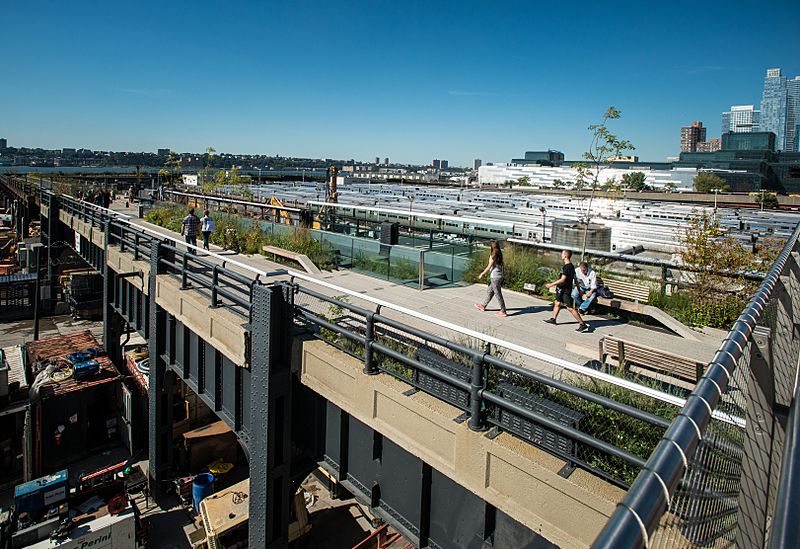Image: New York City High Line - Urban Forestry - 20150915-OSEC-LSC-0172 (20976525663)

Description: Visitors can take their time to enjoy an elevated view of New Youk City from High Line an elevated railway line owned by the City of New York, today a 1.45-mile-long linear public park maintained, operated, and programmed by Friends of the High Line, in partnership with the New York City Department of Parks & Recreation, on Tuesday, September 15, 2015. High Line was opened in 1934 and moved goods to and from Manhattan’s largest industrial district until 1980. The third and final phase officially opened to the public on September 21, 2014. The High Line's green roof system with drip irrigation is designed to allow the planting beds to retain as much water as possible; because many of the plants are drought-tolerant, they need little supplemental watering. When supplemental watering is needed, hand watering is used so as to tailor the amount of water to the needs of individual species and weather conditions, and to conserve water. High Line is independently funded from U.S. Department of Agriculture (USDA) Forest Service (USFS). Urban forestry and green spaces are priority areas for USFS. With 80 percent* of the nation's population in urban areas, there are strong environmental, social, and economic cases to be made for the conservation of green spaces to guide growth and revitalize city centers and older suburbs. Urban forests broadly include urban parks, street trees, landscaped boulevards, public gardens, river and coastal promenades, greenways, river corridors, wetlands, nature preserves, natural areas, shelter belts of trees and working trees at industrial brownfield sites. Urban forests are dynamic ecosystems that provide needed environmental services by cleaning air and water helping to control storm water, and conserving energy. They add form, structure, beauty and breathing room to urban design, reduce noise, separate incompatible uses, provide places to recreate, strengthen social cohesion, leverage community revitalization, and add economic value to our communities. Urban forests, through planned connections of green spaces, form the green infrastructure system on which communities depend. Green infrastructure works at multiple scales from the neighborhood to the metro area up to the regional landscape. This natural life support system sustains clean air and water, biodiversity, habitat, nesting and travel corridors for wildlife, and connects people to nature. Urban forests, through planned connections of green spaces, form the green infrastructure system on which communities depend. Urban and Community Forestry (UCF) is a cooperative program of the US Forest Service that focuses on the stewardship of urban natural resources. UCF provides technical, financial, research and educational services to local government, non-profit organizations community groups, educational institutions, and tribal governments. The program is delivered through its legislative partners, the state forestry agencies in 59 states and US territories. Forest Service cooperative programs are currently being redesigned to make more effective use of federal resources. Programs will be focused on issues and landscapes of national importance and prioritized through state and regional assessments. Over the next five years an increasing percentage of funding will be focused on landscape scale projects. Three national themes provide a framework for this work: conserve working forest landscapes; protect forests from harm; and enhance benefits associated with trees and forests. More information and upcoming webinars on December 9, 2015 | 1:00pm-2:15pm ET; January 13, 2016 | 1:00pm-2:15pm ET; and February 10, 2016 | 1:00pm-2:15pm ET can be seen at *http://www.fs.fed.us/ucf/program.shtml. USDA Photo By Lance Cheung.
Title: New York City High Line - Urban Forestry - 20150915-OSEC-LSC-0172 (20976525663)
Credit: 20150915-OSEC-LSC-0172
Author: U.S. Department of Agriculture
Usage Terms: Public domain
License: Public domain
Attribution Required?: No
Image usage
The following page links to this image:

